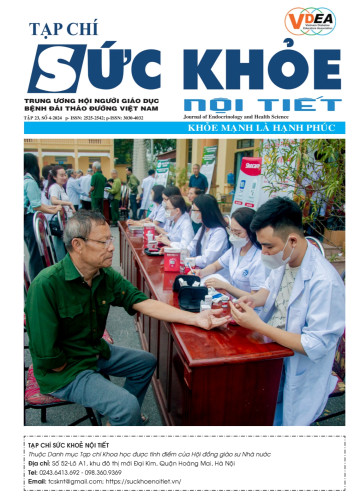Đăng ký
Vui lòng nhập các thông tin cần thiết

TÀI LIỆU THAM KHẢO
1. DeFronzo RA. (2009), From the Triumvirate to the Ominous Octet: A New Paradigm for the Treatment of Type 2 Diabetes Mellitus, Diabetes. 58(4):773–795;
2. Sanjay Kalra et al., (2017), Pentads and Hexads in Diabetes Care: Numbers as Targets; Numbers as Tools, Indian J Endocrinol Metab. DOI: 10.4103/ijem.IJEM_281_17.
3. Zhang et al., (2014), Effect of glycemic variability on short term prognosis in acute myocardial infarction subjects undergoing primary percutaneous coronary interventions, Diabetology & Metabolic Syndrome. DOI: 10.1186/1758-5996-6-76.
4. Yoo S. et al., (2015), Factors Associated with Glycemic Variability in Patients with Type 2 Diabetes: Focus on Oral Hypoglycemic Agents and Cardiovascular Risk Factors, Endocrinology and Metabolism. DOI: 10.3803/EnM.2015.30.3.352.
5. Mori Y, et al., (2011), Effects of sitagliptin on 24-h glycemic changes in Japanese patients with type 2 diabetes assessed using continuous glucose monitoring, Diabetes Technol Ther. 2011 Jul;13(7):699-703
6. ADA, (2019), Diabetes Care, Vol. 42, August 2019; Vol. 46, January 2023.
7. Brownlee et al., (2005), The Pathobiology of Diabetic Complications: A Unifying Mechanism, Diabetes 2005;54:1615–25.
8. Monnier et al., (2006), Activation of oxidative stress by acute glucose fluctuations compared with sustained chronic hyperglycemia in patients with type 2 diabetes, JAMA 2006;295:1681–87
9. Zinman et al., (2018), Day-to-day fasting glycaemic variability in DEVOTE: associations with severe hypoglycaemia and cardiovascular outcomes (DEVOTE 2), Diabetologia 2018;61:48–57
10. Pollack MF et al., (2010), Patient-reported tolerability issues with oral antidiabetic agents: Associations with adherence; treatment satisfaction and health-related quality of life, Diabetes Res Clin Pract. 2010;87:204–210.
11. Morales, J and Schneider D., (2014), Hypoglycemia, American Journal of Medicine 2014;127 (10A):S17-24.
12. Battelino et al., (2019), Clinical Targets for Continuous Glucose Monitoring Data Interpretation: Recommendations From the International Consensus on Time in Range, Diabetes Care. 2019; 42:1593-1603; http://www.agpreport.org/agp/clinics
TÓM TẮT
Dao động đường huyết không chỉ là sự thay đổi ngắn hạn mà còn là yếu tố quan trọng ảnh hưởng đến sức khỏe bệnh nhân. Mặc dù hai bệnh nhân có cùng mức HbA1c, mức dao động đường huyết của họ có thể khác nhau, cho thấy HbA1c không đủ để đánh giá tình trạng kiểm soát đường huyết.
Hậu quả của dao động đường huyết bao gồm nguy cơ hạ đường huyết không nhận biết, stress oxy hóa gây tổn thương mạch máu, và tăng nguy cơ biến cố tim mạch lớn (MACE). Những biến động này cũng làm tăng thời gian nằm viện và chi phí điều trị, đồng thời ảnh hưởng tiêu cực đến chất lượng cuộc sống của bệnh nhân. Việc kiểm soát dao động đường huyết đã trở thành mục tiêu quan trọng trong điều trị ĐTĐ. Công nghệ đo đường huyết liên tục (CGM) giúp theo dõi dao động hiệu quả hơn và giới thiệu khái niệm "Time in Range" (TIR), tức thời gian mà đường huyết nằm trong ngưỡng mục tiêu. Các thuốc như DPP-4 inhibitors được khuyến nghị để giảm dao động đường huyết mà không gây hạ đường huyết hoặc tăng cân.
Do vậy, kiểm soát dao động đường huyết không chỉ là thông số sinh học mà còn quyết định kết quả điều trị và tiên lượng dài hạn cho bệnh nhân ĐTĐ. Việc nhận thức và quản lý hiệu quả tình trạng này là chìa khóa để cải thiện chất lượng điều trị và cuộc sống cho bệnh nhân.
Từ khóa: đường huyết, dao động đường huyết, biến chứng
MANAGING GLYCEMIC VARIABILITY IN PATIENTS WITH TYPE 2 DIABETES MELLITUS
SUMMARY:
Glycemic variability is not only a short-term change but also a significant factor affecting patient health. Although two patients may have the same HbA1c level, their glycemic variability can differ, indicating that HbA1c alone is insufficient for assessing glycemic control. The consequences of glycemic variability include the risk of unrecognized hypoglycemia, oxidative stress leading to vascular damage, and an increased risk of major cardiovascular events (MACE). These fluctuations also lead to longer hospital stays and higher treatment costs, negatively impacting patients' quality of life.
Controlling glycemic variability has become a crucial goal in diabetes management. Continuous glucose monitoring (CGM) technology allows for better tracking of variability and introduces the concept of "Time in Range" (TIR), which refers to the duration that blood glucose levels remain within target ranges. Medications such as DPP-4 inhibitors are recommended to reduce glycemic variability without causing hypoglycemia or weight gain.
Therefore, managing glycemic variability is not just a biological parameter but also a determinant of treatment outcomes and long-term prognosis for diabetes patients. Awareness and effective management of this condition are key to improving treatment quality and the overall quality of life for patients.
Keywords: Plasma glucose, Glycemic variability, diabetes complications